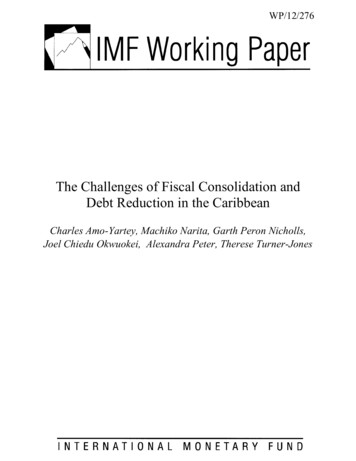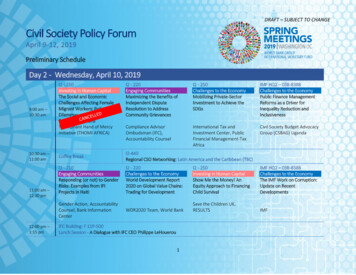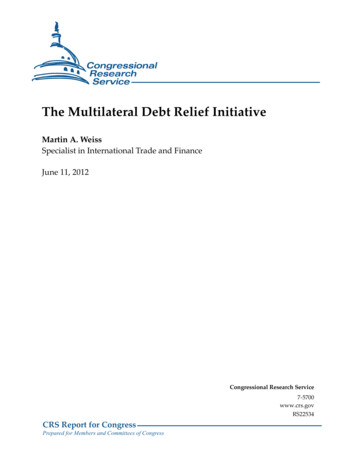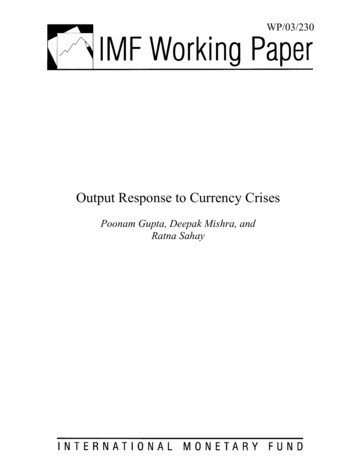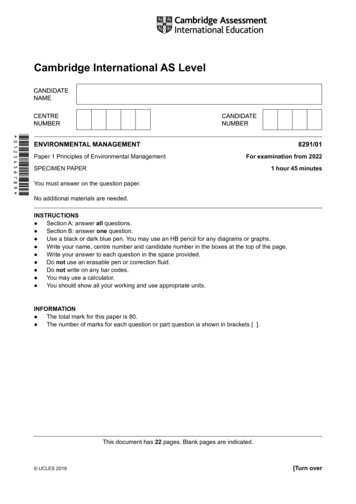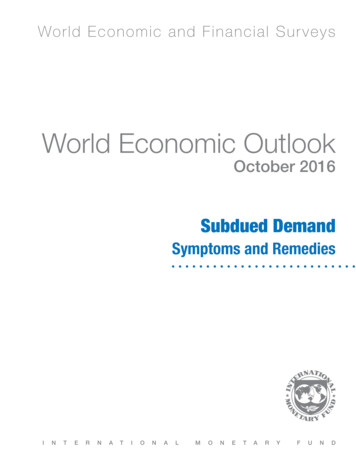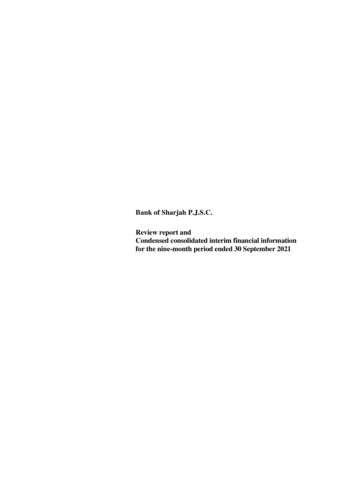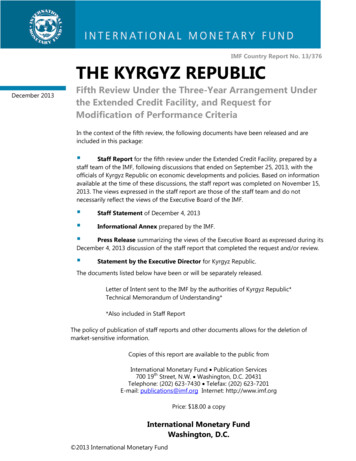
Transcription
IMF Country Report No. 13/376THE KYRGYZ REPUBLICDecember 2013Fifth Review Under the Three-Year Arrangement Underthe Extended Credit Facility, and Request forModification of Performance CriteriaIn the context of the fifth review, the following documents have been released and areincluded in this package: Staff Report for the fifth review under the Extended Credit Facility, prepared by astaff team of the IMF, following discussions that ended on September 25, 2013, with theofficials of Kyrgyz Republic on economic developments and policies. Based on informationavailable at the time of these discussions, the staff report was completed on November 15,2013. The views expressed in the staff report are those of the staff team and do notnecessarily reflect the views of the Executive Board of the IMF. Staff Statement of December 4, 2013 Statement by the Executive Director for Kyrgyz Republic.Informational Annex prepared by the IMF.Press Release summarizing the views of the Executive Board as expressed during itsDecember 4, 2013 discussion of the staff report that completed the request and/or review.The documents listed below have been or will be separately released.Letter of Intent sent to the IMF by the authorities of Kyrgyz Republic*Technical Memorandum of Understanding**Also included in Staff ReportThe policy of publication of staff reports and other documents allows for the deletion ofmarket-sensitive information.Copies of this report are available to the public fromInternational Monetary Fund Publication Services700 19th Street, N.W. Washington, D.C. 20431Telephone: (202) 623-7430 Telefax: (202) 623-7201E-mail: publications@imf.org Internet: http://www.imf.orgPrice: 18.00 a copyInternational Monetary FundWashington, D.C. 2013 International Monetary Fund
KYRGYZ REPUBLICFIFTH REVIEW UNDER THE THREE-YEAR ARRANGEMENTUNDER THE EXTENDED CREDIT FACILITY, AND REQUESTFOR MODIFICATION OF PERFORMANCE CRITERIANovember 15, 2013EXECUTIVE SUMMARYPolitical context. The political environment has been broadly stable, albeit the ongoingdispute with gold company Centerra is creating tensions. In September, the governmentand Centerra signed a memorandum of understanding which stipulated the exchangeof 33 percent of the government’s share in Centerra for a 50 percent stake in Kumtor.Parliament, however, asked for further negotiations with a view to increase the Kyrgyzshare in the joint venture. The Kyrgyz parliament approved the legislation to close theManas Transit Center in July 2014.Background. Growth (both overall and nongold) was strong over the first nine monthsof 2013 (9.2 and 6.1 percent, respectively) and inflation has declined steadily. Intensivepublic investment programs and the decline in gold prices are putting temporarypressures on the current account. The loss of nontax revenues related to the closure ofthe Manas Transit Center next year is creating headwinds for fiscal consolidation.Nonetheless, the medium-term outlook is broadly favorable, despite the slowdown inthe region. System-wide financial stability indicators have been broadly sound and thecapitalization of Zalkar bank, which was renamed Rosinbank, is underway.Program. The program is broadly on track with all end-June 2013 quantitativeperformance criteria, and all but one indicative targets met. The end-Septemberstructural benchmark on issuing regulations to expand commitment control to localbudgets and special means was missed. Issuing the regulations is a prior action for thisreview. The authorities are requesting the sixth disbursement (SDR 9.514 million) tobecome available upon completion of this review.
KYRGYZ REPUBLICApproved ByJuha Kähkönen (MCD)and Mark Flanagan(SPR)The team comprised C. Beddies (head), C. Gicquel, D. Ostojic (allMCD), P. Mathieu (MCM), Q. Chen (SPR) and K. Gvenetadze (ResidentRepresentative). Y. Sobolev (incoming Resident Representative) joinedpart of the mission during his pre-assignment visit. Discussions wereheld in Bishkek during September 18–October 2, 2013. The missionmet with President Atambaev, Head of the Parliamentary BudgetCommission Keldybekov, Prime Minister Satybaldyev, First Vice PrimeMinister Otorbaev, Minister of Finance Lavrova, Chairperson of theNational Bank of the Kyrgyz Republic (NBKR) Asankojoeva, Minister ofEconomy Sariev, other senior government officials, representatives ofdonor community, the private sector, and civil society.CONTENTSRECENT DEVELOPMENTS 4A. Context 4B. Recent Developments 4C. Program Implementation 7D. Medium-Term Outlook and Risks 8POLICY DISCUSSION 12A. Fiscal Policy 12B. Monetary Policy 14C. Financial Sector Policies 15D. Structural Policies 18PROGRAM AND OTHER ISSUES 19STAFF APPRAISAL 20BOXES1. Spillovers from Russia 92. Infrastructure Projects Over 2013–17 113. 2013 FSAP Update Recommendations 17FIGURE1. Recent Economic Developments 2010–13 5TABLES1. Selected Social and Economic Indicators, 2011–18 222INTERNATIONAL MONETARY FUND
KYRGYZ REPUBLIC2. Balance of Payments, 2011–18 233. NBKR Accounts, 2011–14 244. Monetary Survey, 2011–14 255. General Government Finances, 2011–15 (in millions of soms) 266. General Government Finances, 2011–15 (in percent of GDP) 277. State Government Finances, 2011–15 (in millions of soms) 288. State Government Finances, 2011–15 (in percent of GDP) 299. Social Fund Operations, 2011–15 3010. General Government Operations, GFSM 2001 Presentation, 2011–15 3111. Proposed Reviews and Disbursements Under the Three-Year Extended Credit FacilityArrangement 3212. Indicators of Capacity to Repay the Fund, 2013–18 3313. Quantitative Performance Criteria and Indicative Targets Under the Extended Credit Facility,June 2012–June 2013 3414. Structural Benchmarks under the Extended Credit Facility for 2013–14 35ANNEXI. Debt Sustainability Analysis Update 36APPENDIXI. Letter of Intent 47Attachment I. Revised Technical Memorandum of Understanding 57INTERNATIONAL MONETARY FUND3
KYRGYZ REPUBLICRECENT DEVELOPMENTSA. Context1.The current coalition government has maintained a broadly stable politicalenvironment, but the situation remains challenging. The key political controversy remains thedispute related to the Kumtor gold mine. At end-May, supporters of the then jailed leaders of theopposition faction Ata-Jurt (now released) blocked the access road to the Kumtor gold mine and cutits power supply. Government intervention helped normalize the situation, with road access andpower supply restored quickly. The ongoing negotiations with Centerra may lead to renewedpolitical turmoil. The government and Centerra signed a memorandum of understanding (MOU)which stipulated the exchange of 33 percent of the government’s share in Centerra for a 50 percentstake in Kumtor. The MOU was submitted to parliament in mid-September, but members ofparliament called for another round of negotiations to be completed by December 10, 2013,essentially asking for a larger share in the joint venture. The Kyrgyz parliament approved thelegislation to close the Manas Transit Center in July 2014.B. Recent Developments2.Following the sharp contraction in 2012 related to disruptions in gold production, theeconomy is recovering strongly:10 4Growth reached 9.2 percent (year-on-year) in the firstnine months of 2013. Growth was broad based, drivenby the recovery in the gold sector and strongperformance in the transport, communication, trade,and construction sectors. Nongold growth reached6.1 percent (year-on-year).Headline inflation dropped to 6 percent in September,while core inflation has remained in single digits sinceMay.The current account deteriorated in the first sevenmonths of 2013, owing to an increase in imports,primarily related to public investment programs (PIPs)and FDI in the Upper-Naryn hydro-power plants, butalso the decline in gold prices (partly mitigated by therecovery in gold production and therefore exports).The authorities are still studying the potentialmacroeconomic impact of joining the EurasianCustoms Union.INTERNATIONAL MONETARY FUND10Contribution to GDP Growth(Percentage points)8866442200-2-2-4-6Net Taxes on ProductsOtherTradeTransport and CommunicationConstructionAgricultureGold MiningIndustry Without Gold MiningGDP Growth-8Dec-12Feb-13Source: Kyrgyz authorities.350300Apr-13-4-6-8Jun-13Gold Price and Gold Export Value, 2010–13Aug-13(Quarterly data; gold price in U.S. dollars per troy ounce, gold exports in millions of U.S. dollars)2,0001,8001,600250Gold Exports (LHS)1,400Gold Price (RHS)2001,2001,0001501008006004005002000
KYRGYZ REPUBLIC3.The incidence of poverty remains a concern. The overall poverty level increased to38 percent in 2012, from 36.8 percent in 2011, while extreme poverty decreased by 0.2 percentagepoints (to 4.4 percent) during the same period. Poverty in urban areas increased by 4.6 percentagepoints, whereas in rural areas it decreased by 0.9 percentage points. The National SustainableDevelopment Strategy for 2013–17 is in its first year of implementation, and a more detailedprogress report is under preparation.Figure 1. Kyrgyz Republic: Recent Economic Developments, 2010–1315(In y-o-y percent change, cumulativebeginning of the year)403000-5-5-10-101001000-10External Sector, 2010–13Currency Structure of RemitancesEUR(In percent; 2012)0.560(In y-o-y percent change, three-month -2020FoodMay-12-15-20Core20Jan-12GDPNongold ion, 2010–13(In y-o-y percent change)May-11155020Growth, 2010–13Jan-1120USD22.1406020204050Monetary Aggregates and Credit, 2010–13(In y-o-y percent change)302020101050Tax Revenue Performance, 2012–13(In y-o-y percent change)75Revenues from the Customs ServiceRevenues from the Tax Service, excl. Gold ep-11May-11-10Sep-12Reserve MoneyBroad MoneyPrivate 0Remittances 50Sources: Kyrgyz authorities and IMF staff calculations.INTERNATIONAL MONETARY FUND5
KYRGYZ REPUBLIC4.Fiscal policy has remained prudent. Stronger-than-expected growth and higher importsled to an over performance of VAT and income taxes (excluding Kumtor) over the first six months.Nontax revenues from profits of state owned enterprises were also stronger than expected.Expenditures were in line with the program. As a result the end-June deficit was som 2.2 billion,compared with the adjusted target of som 5.7 billion. In early July, the government received abudget support grant (US 20 million) from Russia which will offset the impact of lower gold priceson revenues this year.5.The NBKR continued to maintain a tight monetary policy stance over the first ninemonths of 2013. In particular: Reserve money growth gradually declined from 22 percent year-on-year in January to14.6 percent in September 2013. The NBKR increased sterilization efforts via NBKR notes, but the volume was not sufficient tokeep reserve money growth within the indicative targets for March and June (albeit missed by asmall margin). The indicative target for September was met. The NBKR intervened in the foreign exchange market only once to smooth excess volatility ofthe som, which has depreciated by 2.9 percent against the U.S. dollar and appreciated by3.4 percent against the Russian ruble since the beginning of the year (cross exchange rate). TheNEER has depreciated by 0.5 percent, while the REER has depreciated by 1.7 percent since thebeginning of the year.355NBKR Notes and Reserve Money Growth4Reserve money y-o-y growth (in percent)25Reserve Money Components(In millions of KGS)NBKR Notes and REPOs (in billions of KGS), RHS30100,000NBKR Policy Rate (in 049.0047.00Jul-13Sep-13May-13Jan-13Mar-13Sources: Kyrgyz authorities and IMF staff ov-11Jul-11Sep-11May-11Jan-11Mar-1101.65Daily Exchange Rate, 2012–13(KGS, USD, ep-11Jan-12RMMay-12Sep-12Jan-13May-13Sep-13Source: Kyrgyz authorities.90124NEER and REER(2005 1218412033.001.3531.008229.00KGS/USD (lhs)27.001.25NEER (lhs)REER Source: INS 1330-Jul-13INTERNATIONAL MONETARY FUND28-Jun-13627-May-1325-Apr-1320-Feb-13Sources: National Bank of the Kyrgyz Republic and Bloomberg.1191.30KGZ/RUB 25-Mar-122-Feb-121-Jan-1225.00USD/RUB (lhs)
KYRGYZ REPUBLIC6.The banking sector remains relatively stable and well capitalized, but credit growthhas been strong. Credit to the private sector increased by 36 percent year-on-year atend-September. The main drivers are loans in som with a maturity over six months to agriculture,trade, and industry. Following the strong credit expansion, capital adequacy and liquidity ratios havedeclined, but remain well above the thresholds (Text Table 1). The NPL ratio, which is low for thewhole system but higher for small banks, continued to decline, in part because of high creditgrowth.Text Table 1. Kyrgyz Republic: Selected Financial Soundness Indicators, 1Mar-12Jun-12Sep-12Dec-12Mar-13Jun-13Capital Adequacy 1/Regulatory capital to risk weighted assetsCapital to total .624.616.9LiquidityLiquidity ratioExcess reserves/total 39.068.423.2Asset quality 1,2/Nonperforming loans/total 9Loan-loss provisioning/nonperforming 3.062.9Earnings and profitability 1,2/Return on equityReturn on assetsSource: National Bank of the Kyrgyz 22.51/ AUB is excluded from October 2010.2/ In March 2011, some NPLs were transferred from Zalkar bank to the old AUB and left the system.7.The usury law that was signed into law in late July may further inhibit competition andimpede monetary transmission. The law puts a cap on interest rates that both banks and MFIs cancharge to their clients. The cap is 15 percent above the average weighted interest rate. Given thatoperational and funding costs vary among banks, among MFIs, and in particular between the twogroups, this will limit competition and reduce access to credit, particularly in remote areas. Inaddition, not all costs of a loan are reflected in the interest rate (different types of fees, e.g., loanorigination, etc). Given that the law is already effective, the NBKR intends to calculate weightedaverage interest rates based on annual percentage rates (APRs)—including all other costs of aloan—and make sure to differentiate between the rate for banks and the rate for microfinanceorganizations. This will help mitigate potential negative effects.Text Table 2. Kyrgyz Republic: Interest Rates of Banks and MFIsLoans in KGSBanks20.4MFI34.5Credit Unions31.5Source: National Bank of the Kyrgyz Republic.C. Program Implementation8.The program remains broadly on track. All end-June 2013 quantitative performancecriteria (QPCs) and all but one indicative targets were met (Table 13). A new tax policy departmentwas created in the ministry of finance (at this time, 15 staff are working in the department). TheINTERNATIONAL MONETARY FUND7
KYRGYZ REPUBLICresolution requiring SOEs to report financial and borrowing plans to the state property managementfund and to the ministry of finance was issued on June 10, 2013. The Banking Code has beensubmitted to the parliament on September 27, 2013. The end-September structural benchmark onissuing a regulation on expanding the coverage of the commitment register to include local budgetsand special means was not observed because the authorities needed more time to addressnumerous comments from government agencies. This measure is now a prior action for thecompletion of this review (Table 14). The new owner of Zalkar bank, which was renamed Rosinbank,paid in the first installment of recapitalization.1 The new owner intends to rebrand the bank andprovide a broader range of services (including mobile banking and automated tax payments).D. Medium-Term Outlook and Risks9.Despite the decline in gold prices, the slowdown in the region, and headwinds forfiscal consolidation from the closure of the Manas Transit Center, the medium-term outlookremains broadly favorable: Because of strong growth performance over the first nine months, the projection for this yearwas revised upward, with growth expected to reach at least 7.8 percent. However, due to theslowdown in Russia (Box 1), which transmits to the Kyrgyz Republic via remittances and externaltrade channels with a lag, growth for 2014 was revised downward from 7.5 percent to6.5 percent. Growth is expected to stabilize at 5 percent over the medium term, supported byinfrastructure investments and better access to credit. With the revised growth outlook, revenues from VAT and income tax are expected to weaken asautomatic stabilizers take effect. Therefore, the fiscal deficit is projected at 4.1 percent in 2014,compared to 4.0 percent at the time of the fourth review. The medium-term adjustment pathremains unchanged with the fiscal deficit expected to narrow to 2.3 percent by 2016. The current account deficit is estimated to decline to 10.4 percent of GDP in 2013, helped by therecovery in gold output (back-loaded in Q4), and lower food and fuel prices. Because ofsubstantial import-intensive FDI and infrastructure loans (Box 2), the current account deficit isexpected to widen to 15.7 percent in 2014 and decline gradually over the medium term. Whilethe persistence of current account deficits remains a concern for external stability, importsrelated to the recently contracted concessional PIP loans and to a larger extent forthcoming FDIdo not create additional pressures on the balance of payments. Taking this into account,reserves continue to be broadly adequate. The authorities agreed with the near- and medium-term projections, but highlighted thatgrowth this year could be higher.1To date, the new owner has paid US 8.5 million (76 percent of total capital to be replenished by the investor).8INTERNATIONAL MONETARY FUND
KYRGYZ REPUBLICText Table 3. Kyrgyz Republic: Medium-Term Outlook, .68.0(Percentage change)Real GDPNongold real GDPInflation (eop, year-on-year)6.54.07.05.35.06.05.05.06.0(Percent of GDP, unless indicated otherwise)Gross investmentGross savingsFiscal balanceCurrent account balanceExternal public debt outstandingGross reserves (months of next year imports, eop)Reserve money growth (12-month change, in 2.3-12.443.73.59.0Sources: Kyrgyz authorities and IMF staff calculations.Box 1. Kyrgyz Republic: Spillovers from RussiaThe slowdown in Russia is expected to affect the Kyrgyz Republic via remittances and external trade channels andultimately domestic demand, consumption, and tax revenues.Remittances account for 30 percent of GDP in the Kyrgyz Republic and about 95 percent of remittances comefrom Russia. Given the high elasticity of remittances to growth in the host country (the literature suggests that a1 percent slowdown in growth will result in a 2 percent slowdown in remittances; the slope coefficient in the caseof the Kyrgyz Republic is about 2.86), the channel will impact the Kyrgyz growth rate through weaker demand anddomestic consumption. As a result, a slowdown in remittances would eventually result in lower tax revenues(Box 3.2 in the 2010 Middle East and Central Asia Regional Economic Outlook). The growth correlation betweenthe Kyrgyz Republic and Russia seems to be weaker in the 2000’s than before, as domestic factors (naturaldisasters and political revolutions in 2002, 2005, 2010, and 2012) dominated. Country Report 13/34 suggests thatoutput linkages between the Russian and the Kyrgyz economies are not strong, with a correlation of 0.4.Correlation of Russian and Kyrgyz growth has weakeneddue to domestic factors in 2002, 2005, 2010, and 2012.Remittances inflows are highly correlated with growth inRussia.200080Inflow of Remittances from Russia, US mill. (lhs)1515Russia Real GDP Growth (rhs)1800Russia Nominal GDP Growth (rhs)60Growth Rate of Remittances from Russia 400-20200-35-15-20Russia GDP Growth-45Kyrgyz GDP L MONETARY FUND9
KYRGYZ REPUBLICBox 1. Kyrgyz Republic: Spillovers from Russia (concluded)Russia remains an important trading partner, in particularimports of fuels and still a significant export er CIS39%China22%Other CIS17%Other11%China4%Sources: Kyrgyz authorities and IMF staff estimates.External trade is another channel for transmitting spillovers to the Kyrgyz Republic. Imports from Russia accountfor 34 percent of total imports, of which 40 percent is fuel (nonelastic import). Imports may increase partly onaccount of more affordable goods from Russia. Exports to Russia are mainly clothing items, machinery, and food.Given that these exports account for 13 percent of total exports, the direct trade impact is expected to be limited.However, second round effects of weaker demand in other CIS countries because of weaker demand in, and lowerremittances from, Russia may have a larger effect on the Kyrgyz Republic. The Kyrgyz Republic is the mainre-exporter of Chinese goods to CIS countries. Exports to CIS countries account for over one half of total exports,while trade accounts for 16 percent of GDP in the Kyrgyz Republic (and contributed about 1.6 percent to GDPgrowth in both 2011 and 2012).10INTERNATIONAL MONETARY FUND
KYRGYZ REPUBLICBox 2. Kyrgyz Republic: Infrastructure Projects Over 2013–17The Kyrgyz Republic is embarking on an intensive public investment program (PIP) for infrastructure projects. PIPsrequire substantial imports, widening the current account deficit. Because these PIPs are financed mostly by FDI andto a lesser degree by concessional loans, there is a limited impact on the balance of payments and debt sustainability(Annex I). While the large-scale hydropower project (Kambarata) could secure the long-term energy needs of theKyrgyz Republic, it will be important that the project is based on a sound feasibility study and its financingarrangements do not jeopardize debt sustainability and macroeconomic stability.PIP loans are estimated at around400US 1,326 million over period 2013–17, of350which about 60 percent will be funded by300China. The PIP loans from China250(US 800 million) were contracted for two200projects: construction of an alternative150highway from north to south and theBishkek thermal power plant. Previous PIPloans were contracted for the reconstructionof highways, municipal infrastructure, andthe energy sector.Composition of PIP Loans in the Kyrgyz Republic, 2011–17(Annual data; in millions of U.S. dollars)OthersChina100500Sources: Kyrgyz authorities and IMF staff estimates.FDI over the medium term is also mainly from China. According to an agreement signed during the visit of theChinese president to Bishkek in September 2013, China will allocate an additional US 2.2 billion in FDI to invest inpublic infrastructure over the coming four years. Out of this amount, US 1.4 billion will be used for building a gaspipeline from Turkmenistan to China, for which the Kyrgyz Republic will receive royalties from China after thepipeline starts operating. Income from the pipeline is expected to range from US 35 million starting in 2017 to upto US 70 million. The remaining US 800 million will be allocated to improving an oil refinery.This large scale investment program will increase imports of goods and services related to projects, such asconstruction materials, from 2014 to 2017 and hence a slower recovery of the current account deficit in thecoming four years. Because the imports are financed by either PIP loans or FDI, the overall balance of payment willnot be affected much, nor the exchange rate. The impact on the real economy during the construction period isuncertain, as the concrete plan for construction is yet to be put in place. However, the impact is expected to belimited. Based on the operation of the existing PIP projects funded by China, the major contractors of the projectsare Chinese companies and the majority of skilled labor comes from China, construction materials are also mostlyimported. The impact on the domestic economy is mainly through hiring unskilled labor and daily supply of goodsand services to the contractors, such as food.The feasibility study for the Kambarata hydropower project is expected to be finalized by the end of the year,providing more details about the joint investment with Russia. The Kambaratinsk Dam is the sixth planned dam onthe Naryn River in the central Kyrgyz Republic. It would become one of the largest dams in the world, once it iscomplete. The hydroelectric power plant at the base of the dam would generate 2,000 MW.INTERNATIONAL MONETARY FUND11
KYRGYZ REPUBLIC10.Risks to the outlook are significant but manageable. Political turmoil, fueled by furtheraggravation of the situation surrounding Kumtor, could result in policy slippages and a slowdown instructural reforms. Lower gold prices could pose additional challenges for balance of paymentsstability. The security situation in Afghanistan could also deteriorate after the NATO troopwithdrawal in 2014, and this could in turn spill over to neighboring countries, including the KyrgyzRepublic. A protracted slowdown in Russia and Kazakhstan, as a consequence of unfavorabledevelopments in advanced and other emerging economies, could spill over to the region via theremittances and external demand channels. The financing arrangements for the Kambarata hydropower project, which will become clear after the completion of the feasibility study, could exposethe Kyrgyz Republic to substantial fiscal and debt sustainability risks. The economy also remainsvulnerable to global oil and food price shocks which could raise imports and inflation, and couldalso be hit by further disruptions in gold production and lower gold prices. These shocks wouldaggravate external vulnerabilities by putting pressure on international reserves. The recovery in goldproduction along with strong growth in other sectors and continued implementation of programpolicies will help to mitigate these risks.POLICY DISCUSSIONA. Fiscal Policy11.Despite the lower gold price, the deficit target for 2013 remains achievable. The overallnominal deficit target of som 18,273 million remains unchanged, but is slightly lower as a share ofGDP due to the upward revision of GDP (5.2 percent vs. 5.3 percent at the time of the fourth review).The adjustment in the primary balance of 0.1 percent of GDP in 2013 relative to 2012 is broadly inline with the original program (Text Table 4). The authorities are continuing to streamline nonpriorityspending, while preserving social and increasing capital outlays (LOI¶4).Text Table 4. Kyrgyz Rep
IMF Country Report No. 13/376 THE KYRGYZ REPUBLIC Fifth Review Under the Three-Year Arrangement Under the Extended Credit Facility, and Request for Modification of Performance Criteria In the context of the fifth review, the following documents have been released and are . Customs Union. KYRGYZ REPUBLIC INTERNATIONAL MONETARY FUND 5-20 0 20 .
